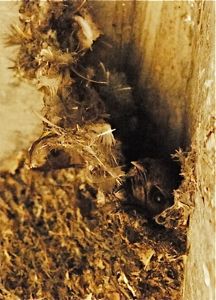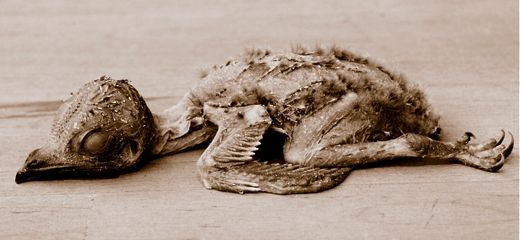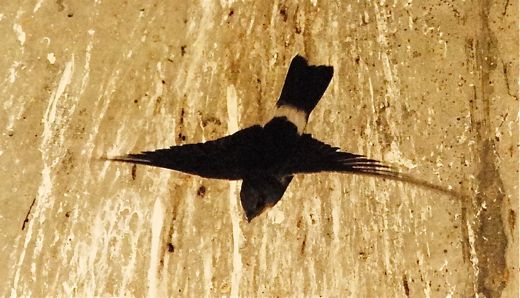“Yesterday I noticed a group of four to five House Swifts (Apus affinis) circling in the airspace under an Mass Rapid Transit viaduct at around 0900 hours. The weather was fair. Two of them deviated from the circular trajectory at regular intervals to ascend towards, but not establish contact with, a nest glued under the viaduct adjacent to one of the pillars (left). By 0945 hours they were nowhere to be seen.
“There were two additional nests joined to each other (as reported in the literature to happen frequently) near the next pillar. I noticed that in this instance the nests were underhanging precariously from a (mostly) horizontal surface, not vertical surfaces as often described. This is even more remarkable in consideration of the strong vibrations caused by trains passing every few minutes throughout the day. Indeed, the demographic success of this species can be at least partly attributed to their amenability to nest sites of high levels of human and vehicular traffic. On the ground under the nest cluster I found a pile of ‘guano’ beside which was a dead chick (below).
“I assume that it is A. affinis. The reasons for falling from the nest have been documented in past BESG postings. If the chick is indeed A. affinis, the legs are remarkably disproportionately long for apodids and will presumably develop allometrically into the adult form. At the moment, it superficially resembles the recently reported Acridotheres javanicus chick. This morphological similarity across chicks/embryos of different avian families seems to be one of the hallmarks of Darwinian evolutionary theory.
“Today, the A. affinis did not indulge in the cyclic flight patterns observed yesterday at the same time. Could anyone suggest ethological or ecological rationales for the observed behaviour? Nevertheless, they spent the morning foraging and feeding their progeny, leaving and returning to the nest repeatedly. Unfortunately, I could not see their captures.
“The above shows what appears to be a powered anticlockwise rotation of the bird along its anterioposterior axis a fraction of a second after ejection from the nest, the right wing being ventrally convex and the left wing dorsally so.
“In the above, the parent is about to leave the nest with its head facing out. It made a ‘gostan’ inside the nest after entering. However, the adults in the other nests seem to commence their exit backwards and switch to forward propulsion as gravitation takes over. Space limitation (dependent on nest volume, surviving brood size etc.) probably plays a role in determining the exit direction. Obviously, exiting head first offers better prior assessment of the security situation outside the nest.”
House Swifts are common resident birds.
Lin Yangchen
Singapore
May 2008












One Response
Thank you so much for the pictures and notes. I get confused between swallows, martins and swifts. My rule of thumb is that the birds i usually see shooting about in groups and whose faces i can barely glimpse for their speed, are swifts, the same ones that build their nests on rafters. Swallows have longer tails.